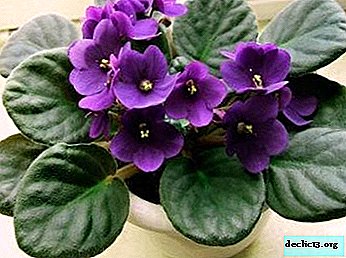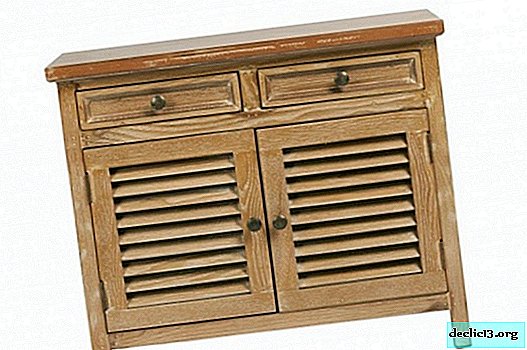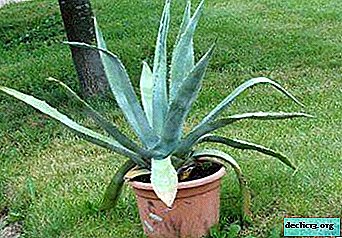Features of planting, growing catharanthus, as well as caring for it with a photo

This evergreen inhabitant of the tropics is often found in the garden. However, growing a plant is not only about decorating flower beds. Today katarantus is a fashionable trend for decorating window sills, verandas, attics, terraces. And not in vain, because caring for him is elementary.
However, you should know the basic rules in order to prevent serious mistakes when growing Catharanthus. You will learn more about planting and growing a flower; see how the planted plant looks in the photo.
How to care?
When an exotic handsome man appears in the house, the situation immediately changes. Another microclimate is created, the energy situation, the plant, as it were, energizes, improves mood, stimulates performance. It seems that the catharantus brought to the housing a Mediterranean flavor, a feeling of warmth and sun. Therefore, for him, I want to create ideal conditions at home.
Temperature
Tropical and subtropical climate is considered the natural habitat of the plant. And of course, catharanthus prefers warmth. In summer, the optimum temperature should be + 23-26 ° C, and there should also be high humidity. In the cold season + 15-17 ° C is not lower. The shrub is very afraid of cold weather, for it a temperature of + 10 ° C is the ultimate indicator. With prolonged exposure to such conditions, the flower may die.
In the warm season, the plant can be carried out in a pot on an open balcony or veranda. But if night cold is possible, it is better to bring back. The warmer and lighter, the brighter and more magnificent the catharanthus blooms.Lighting
 The plant develops well in intense light. If possible, it is better to choose window sills from the western or eastern side. Scorching sunlight is advised to shade with a tulle curtain.
The plant develops well in intense light. If possible, it is better to choose window sills from the western or eastern side. Scorching sunlight is advised to shade with a tulle curtain.
In summer, the flower can be taken outside, however, choose a place in partial shade, and where it does not flood rain. And in the winter season, it is recommended to put the flower pot on the window on the south side, there is more light.
In the period with a short daylight, catharanthus requires additional lighting, which is created by phytolamps. These lighting devices give a lot of light, but do not dry the air in the room, which favorably affects the plant. Phytolamps are placed at a distance of 60-70cm from the bush, otherwise thermal burns of the leaves are possible.
The soil
Catharanthus is generally not demanding on soil characteristics and composition. The earth should be light, breathable, fertile, not acidic. The flower grows well in moist soil, so an important feature is the ability of the soil to retain water.
From ready-made industrial mixtures, soil for geranium or a universal soil mixture for flowering plants is suitable. However any finished substrate should be brought to the desired condition, friability and moisture capacity.
For self-preparation of the substrate, such components are required:
- deciduous land;
- soddy soil;
- peat;
- coarse sand;
- natural baking powder.
Another important condition is the presence of a drainage layer at the bottom of the pot. Without it, problems with the root system may occur in the future as a result of stagnation of water. As drainage used:
- pebbles;
- broken brick;
- fine gravel;
- expanded clay granules.
Pot selection
 An important aspect in the development of the plant is the correct size of the pot. It should not be small, because the catharanthus grows quickly, and free space is necessary for its root system.
An important aspect in the development of the plant is the correct size of the pot. It should not be small, because the catharanthus grows quickly, and free space is necessary for its root system.
It is preferable to choose a container of clay or plastic. It is these materials that are more accessible and manifest themselves well during operation.
For each transplant, the size of the pot in diameter should be increased by 2-3 cm from the previous one. At the bottom of the pot must have drainage holes for draining the liquid, if there are none, then you need to do it.
Watering
Katarantus, like any other representative growing in tropical or subtropical areas, plentiful timely watering is important. This requirement for water balance is especially noticeable in the summer season, when it is very hot. Then moisten the flower should be daily, but not to allow the gulf. It is not good when the soil in the pot is completely dry.
Be sure to monitor the state of the earth. With a lack of fluid, the leaves are folded into a tube, and after watering take a natural form. For catharanthus, preferably moist soil. After watering, you need to remove the excess water formed in the pan under the pot.
The quality of the water used also matters. It should be watered with warm, rain-settled liquid. Water is maintained for about 2-3 days.Another point is the increased humidity in the room. Experienced gardeners advise daily spraying of foliage, but not flowers. Use water and a spray bottle for this. The desired indicator of air humidity is 70-80%. Also, to maintain a given parameter, you can put a container with wet pebbles or sand next to the flowerpot.
Top dressing
The period when the plant is in dire need of nutrition is March-September. Then the bush is fertilized with complex mineral fertilizers 1 time in 10 days. Once every 2-3 months, an aqueous solution with wood ash is used.
Also in this period, you can use foliar dressings, which should be carried out 1 time per month. The best drug for this is Epin-Extra. With the advent of autumn, the karantum ceases to feed, and such "starvation" lasts until spring. Be sure to fertilize the flower only on moist soil and dosage in accordance with the instructions.
Pruning
Every 5 years, the catharanthus is given this rejuvenation: they cut off the stiffened central trunk, and root it. The pruning procedure is carried out so that the bush is more magnificent and has the correct shape. Pruning a plant in spring, because during the winter, as a result of a lack of light, the shoots are very extended. If there is a need, they do additional pruning in the summer, when the plant has lost its decorative appearance and it is worthwhile to form a crown. But this can trigger a fairly late flowering plant.
Still pruning is performed by dry leaves and flowers, in this case the procedure is shallow.
Photo
Below you can see how the flower looks.




Diseases and Pests
The tropical shrub is quite resistant to damage by various diseases and parasites. However, with abundant watering, fungal infections occur, which are expressed by brown spots on the leaves and rotting of the root system.
These infections are nothing but pathogens such as root rot or leaf rust. They arise if the plant is kept in damp and cramped space.You can cure a room flower if:
- eliminate all affected areas;
- treat the plant with a fungicide solution;
- transplant the flower into a new pot and soil.
However, most troubles with catharanthus occur as a result of illiterate care of the bush:
- For example, why flower leaves turn yellow? Perhaps this is evidence of a low temperature in the room, mainly this happens in the winter during the operation of heating appliances.
- A small number of flowers signals sharp fluctuations in temperature. For example, when you open a window during a cold snap, as a result, the flower is cold or the presence of drafts. Katarantus reacts quite sharply to cold air. The warmer for him, the brighter and more magnificent he blossoms.
- Sluggish leaves talk about the wrong choice of place for the plant. There may be an excess of sunlight, or it’s just hot. On hot days, especially during the day, scorching rays should be shaded. Or rearrange in a place with diffused light.
- Leaves fall. If the leaves turn yellow, dry, and then the lower leaves fall, then the shrub simply gets rid of them. Such a phenomenon should not cause unrest - it is a natural process of leaf aging.
Prevention
In order to avoid such unpleasant situations in the future, do not neglect the recommended conditions for growing Catharanthus.
- Room temperature in the summer is in the range + 25-26 ° С.
- Winter temperature + 14-17 ° C.
- Avoid drafts, temperature extremes, hypothermia.
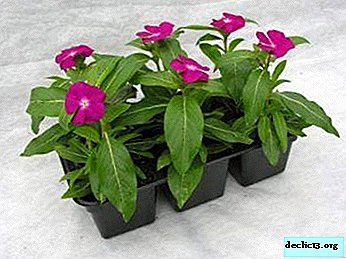 A tropical shrub loves light, but in hot periods you need to be careful with the sun's rays.
A tropical shrub loves light, but in hot periods you need to be careful with the sun's rays.- Water in a timely manner, monitor the level of moisture in the pot.
- Requires moist air in the room.
- Use fertilizer every 2 weeks.
- Trim yellow, dry leaves and inflorescences.
- Loosen the soil, wipe the leaves with a damp cloth.
- Subject to water procedures, a warm shower, spraying.
Pests
Cataractus, rarely, but happens to be attacked by harmful insects.
With dry air, harmful insects - scabies and spider mites, aphids - spread in the room. For a person, the juice of a flower is dangerous, but for insects, on the contrary.Before you bring catharanthus into the house, inspect it so as not to infect other plants. If the flower is chosen by unwanted "neighbors", the foliage should be treated first with a soapy solution. In the absence of a positive result - chemical preparations of insecticides:
- "Actara."
- "Commander."
- "Biotlin."
Flower planting
Transplantation is a must, which is required to be done every year. So often because the plant grows and develops quickly enough. Its root system also increases in volume. Thus, when transplanting, it is recommended to change the pot, increasing it in size. Before use, which is better to pour over boiling water. Drainage and soil mix take new.
- First of all, the plant is carefully removed from the old container, trying not to damage the roots. Since they are quite thin and fragile. To do this, if the pot is plastic, you can cut it. If not, then water abundantly and wait until the soil becomes sour.
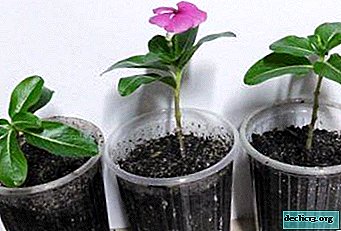 Carefully inspect the root system. If dry or rotten processes are detected, they should be removed with a sharp tool.
Carefully inspect the root system. If dry or rotten processes are detected, they should be removed with a sharp tool.- Amputation is important 4 cm above the affected area, for further growth of rot.
- Sites of cuts should be treated with gray or wood ash.
- Plant in a pot and sprinkle with earth.
- Sprinkle a little on top.
What to do next?
Even if the plant tolerates transplants not bad, then all the same the first time it gets sick, adapts to a new place. Therefore, during this period, it is better not to touch the flower. Lightly moisten with warm water, put in a warm and bright place. After the appearance of new processes, restore the diet.
Useful video
Watch a video about landing a cataranthus and taking care of it at home:
Conclusion
To make your house transformed, and the interior to sparkle with new colors, do not start expensive plants that require troubles and worries. But the cultivation of Catharanthus is an easy job that brings pleasure and a magnificent, beautiful result.

 A tropical shrub loves light, but in hot periods you need to be careful with the sun's rays.
A tropical shrub loves light, but in hot periods you need to be careful with the sun's rays. Carefully inspect the root system. If dry or rotten processes are detected, they should be removed with a sharp tool.
Carefully inspect the root system. If dry or rotten processes are detected, they should be removed with a sharp tool.
